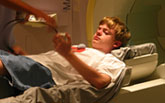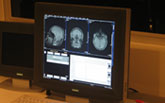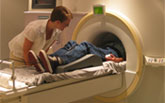Psychologists Use fMRI to Study Autism-Learning Connection
by Linda Hill

People with autism can be highly intelligent, but the way their brains work when they learn may be distinctly different from those without the disorder.
This difference is the focus of a cutting-edge research project under way by Drs. Mark and Laura Klinger of The University of Alabama psychology department.
The Klingers, who are both principal investigators in the study, are trying to better understand the ways in which persons with Autism Spectrum Disorder, or ASD, their parents, and those without ASD, learn and remember new information. The Klingers hope to gain this understanding by studying brain activity patterns through fMRI, functional magnetic resonance imaging.
Difficulties in social interaction — including knowing how to make friends — poor conversation skills, and obsessive interests in routine behaviors are characteristics of people with Autism Spectrum Disorder. Diagnoses of Autistic Disorder and Asperger’s Disorder both fall within this spectrum.
Researchers believe persons with ASD are born with the disorder, a neurological disability. Children with autism often have difficulty learning things that normally developing children learn automatically — or through implicit learning, the Klingers say.
“Autism is a learning disability in implicit or automatic learning. We can teach children with ASD to compensate by using explicit — or rule-based — learning,” Laura says.
Learning how to talk and relate to other people by picking up on social cues, such as knowing when to end a conversation or when someone is happy or sad, is difficult for children with ASD who have to be told or taught by an explicit set of rules how to handle daily situations.
“If you can’t figure out the rules of language, social interaction and how to read facial expressions, you will have a hard time living in a world that expects you to pick up these complex patterns on your own,” says Laura Klinger, a clinical child psychologist who has worked with children with ASD for more than 20 years. “We can teach children with ASD to compensate for their difficulty understanding the complexities of social interaction through rules, but it is still not the same as the way the typical individual learns this information.”
Learning more about how the autistic brain works may help families, teachers and those with the disorder in their academic and daily lives.
 “We think that children with autism are using a different set of mental processes to learn new information, and that those processes occur in different parts of the brain,” says Mark. “We think that explicit (or rule-based) learning tends to takes place in the frontal lobe while we think implicit (or automatic) learning occurs deep inside the brain at the basal ganglia,” says Mark Klinger, a cognitive psychologist who focuses on implicit thought processes.
“We think that children with autism are using a different set of mental processes to learn new information, and that those processes occur in different parts of the brain,” says Mark. “We think that explicit (or rule-based) learning tends to takes place in the frontal lobe while we think implicit (or automatic) learning occurs deep inside the brain at the basal ganglia,” says Mark Klinger, a cognitive psychologist who focuses on implicit thought processes.
The husband-wife psychologist team from UA is working with Dr. Read Montague of Baylor College of Medicine Human Neuroimaging Lab in Houston and Dr. Michael Friedlander of the UAB Civitan International Research Center.
The first phase of research has been conducted at Montague’s Human Neuroimaging Lab at Baylor College of Medicine. The Klingers, along with Dr. Friedlander and two UA graduate students, traveled to Houston with a group of seven teenage boys (age 13-18) with ASD and their parents who had volunteered participation. The boys were known to the Klingers through their work in the UA psychology department’s clinic and outreach services for those with ASD and their families.

In the study, the boys played three different computer learning games, programmed by Mark Klinger and his graduate students, at the same time the researchers were looking at how the boys’ brains were working through an fMRI. An fMRI is a type of MRI that generates high-quality pictures of the brain and measures levels of brain activity associated with functioning at a particular time; it doesn’t use X-rays or radiation. The study is designed to better understand what areas of the brain were activated when the boys with ASD tried to learn different types of information.
While it’s too early to be certain, the UA researchers suspect that because youth with ASD in the study use a different set of mental processes to learn new information, they will be using a different part of the brain than those without the disorder, and this will be shown in the fMRI results.
During the fMRI scans, the boys, who were not given any medication, had to lie still while they used hand-held controllers to play the learning games that were reflected on an overhead mirror they could view. They were in the scanner for two 20-30 minute scans.
“We are interested in seeing how the brain images of the youth with ASD doing the learning tasks in the study are different than those of typically developing brains,” Laura Klinger says.
This phase of their work is a continuation of the Klinger’s innovative research on autism that is funded by the National Institutes of Health.
Further Reading
